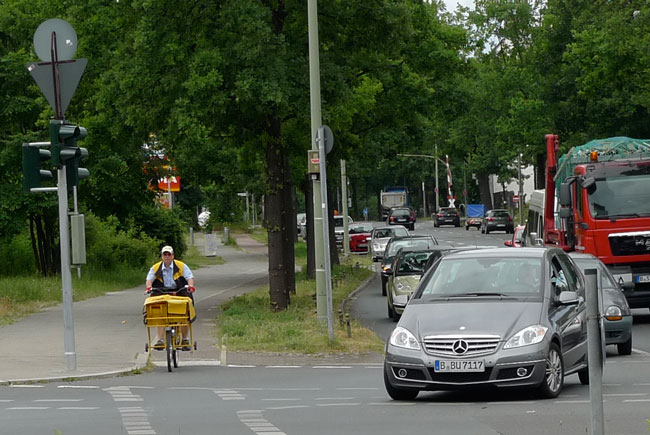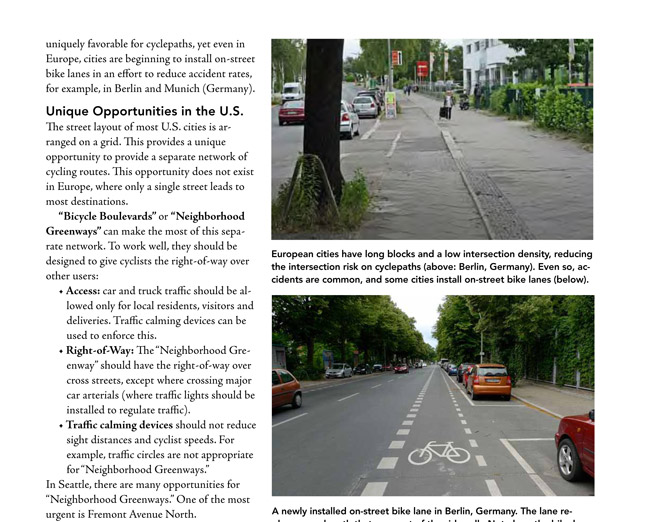Separated Cycle Paths: Who Asks the Cyclists?

In the discussion about separate or “protected” cycle tracks, it has been surprising that planners and decision makers don’t seem to want input from those who actually ride bikes.

In some cases, there is open disdain for those who have been cycling in North America for many years. Now that cycling is becoming popular, largely through the example and tireless efforts of these cyclists, we are labeled “a frustrating deterrent to mainstreaming cycling” on the popular “Copenhagenize” blog. The author even suggests that we hit our children, and insinuates that we prefer to mix with cars and trucks on freeways rather than ride on a separate path. (We don’t, the photo in the blog shows a location where a cyclepath actually makes sense.)
Those are extremes, but the tenor isn’t much different when you talk to many bicycle advocacy groups who have jumped onto the cycle path bandwagon.

Why this animosity? Because many experienced cyclists don’t want to ride on segregated cycle paths (except in the very rare instances where they actually make sense). For the most part, they prefer to share quiet streets with slow-moving cars, rather than ride on “protected” paths that put them in harm’s way at each intersection. And if they have to ride on busy streets, they prefer on-street bike lanes that keep them visible and predictable to other traffic.
On the other hand, if you ask non-cyclists what they would be afraid of – if they were on a bike – many will tell you that it’s cars. To those unfamiliar with riding in traffic, it can make apparent sense to “separate” cars and bikes in order to provide “protection.” But many non-cyclists don’t understand the real risks of riding bikes… which occur at intersections.

What about those who actually have ridden their bikes for many years? Even in Berlin (above), where cycle paths were mandatory until recently and remain deeply ingrained in the culture, more and more cyclists prefer to ride on the street, rather than use unsafe cycle paths (the path is on the right in the photo above).
Even more experienced cyclists in North American are opposed to segregated cycle paths. When “physically separated cycle tracks” were mentioned on the popular Bike Portland Blog recently, the vast majority of comments was by cyclists voicing their dislike of these facilities – even though the blog post only mentioned the cycle paths in passing.
So why doesn’t anybody want to listen to those who actually ride bikes for transportation? It’s true that some experienced cyclists aren’t exactly welcoming to newcomers. So it’s easy to see them as “obstacles” that stand in the way of recruiting more cyclists. But most cyclists are genuinely interested in getting more people on bikes. However, their experience tells them that the “solutions” proposed right now won’t work well in North America. Yet their experience and concerns are dismissed without further discussion.
The push for “protected bike lanes” comes mostly from well-meaning architects and planners. Architects and planners tend to see the world through a lense of facilities. That is their job – designing and building things. When they see a problem – getting more people on bikes – their reflex is to design something to make this happen.
And that points to the next problem: There is real money in segregated cycle paths. Money for consultants. For example, the author of the “Copenhagenize” blog makes a good living by consulting cities on how they can become like Copenhagen – by building cycle paths. There is money for engineers and architects who design the actual facilities. (The contractors may be least to blame, since roads will be built no matter what.) It appears that a whole industry has sprung up around this.
Take the most-often-quoted studies that purport to show that cycle tracks are safer than riding in the street. They are authored by an architect with a background in designing cycle tracks. That alone does not disqualify her, but when her studies are seriously flawed in almost all respects, one wonders about the conflict of interest. Yet those studies are accepted at face value, because they are what decision-makers want to hear. It’s a clear case of group-think, and anybody who stands in the way will be ignored.
That means ignoring actual before-and-after studies of streets where cycle paths were built in Denmark. There are several such studies, including this one from Copenhagen. They all show that bicycle accidents and injuries increased when cycle tracks were installed, because more accidents occur at intersections. (And yes, the studies did account for increases in ridership that occurred with the new facilities.) So when experienced cyclists say that cycle paths are not safe, their assertion actually is supported by the data.
Instead of fostering an open discussion about the infrastructure of the future, we have seen a back-door push for separated cycling facilities.

Now the federal government is “quietly circulating” a proposal to consultants (above), to design guidelines for separate cycle tracks. The proposal mentions:
“There is a growing body of research on cycle tracks in the U.S. and Canada indicating that, when they are designed well, they do not increase bike crash rates. There is also growing evidence that cyclists prefer cycle tracks over other design treatments that require them to operate within or near motor vehicle traffic.”
That “growing body of research” are the flawed studies mentioned above. Even the well-designed Danish cycle paths cause an increase in bike crash rates. It’s unlikely that we’ll do better in the U.S. than the cycle paths of Copenhagen.
And it does not appear that “cyclists prefer cycle tracks”, either. Most current cyclists understand the risks they pose. The proposal assumes that the matter has been settled, and that the only thing left is to implement the segregated cycle paths.
It is time to voice our opposition. This policy change is happening now – the deadline for the government proposals is today (August 14). Instead of blindly adopting cycle paths, we should have an open discussion of what needs to be done to create an environment where cyclists feel safe and are safe.
I suggest we start by e-mailing the contact for the federal proposal above at Geopardi.Bost@dot.gov. Ask her to forward your comments to the person in charge of setting policies.
This blog has over 4000 readers. If the Federal Highway Administration gets 4000 e-mails opposing the wholesale adoption of cycle paths, they may realize that there is a “silent majority” out there that has been overlooked.
Here are some talking points:
- Cycle paths make cycling more risky, because cyclists arrive at intersections without being visible to car traffic.
- The “intersection risk” makes cycle paths a poor choice for most North American cities, with their many intersections, and relatively poorly trained drivers.
- The grid layout of most North American cities allows for a separate network of “Bicycle Boulevards,” where cyclists can cycle on low-traffic streets, rather than fight for space on the main arterials used by cars.

I wrote about this in more detail in comments to Seattle’s Bicycle Master Plan. You can find that 5-page pdf document (1.6 mB) here.
The next step is contacting your local bicycle advisory group, and ask them how they stand on cycle paths, and what they think about the intersection risk of cycle paths. If they are unwilling to consider these points, don’t support them. (I cancelled my membership in the League of American Bicyclists.)
What we need is a measured discussion of the best way forward. We need to develop solutions that work for North America’s unique geography and culture, rather than try and copy Europe. Most of all, we need to make our voices as cyclists heard in the back-room meetings of those who are trying to implement a policy that profits them, but that may not be in the interest of those actually riding bicycles.
Further reading:


